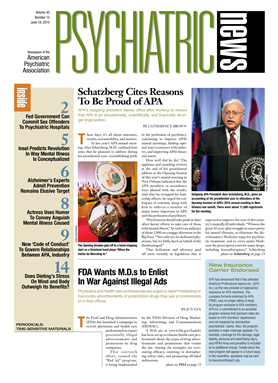Advocates for more and better-funded suicide-prevention programs hope that the latest federal finding that suicide continues to account for the majority of violent deaths in the nation will spur legislative action on initiatives to reduce that tragic toll.
Suicide accounted for 57 percent of violent deaths in 2007—the latest year for which data are available—according to federal sampling data from 16 states released by the Centers for Disease Control and Prevention (CDC) in May. The dominant role of suicide—defined by the authors as any intentional self-inflicted death—in violent deaths mirrors findings in previous years by the CDC's National Violent Death Reporting System.
Those findings, which demonstrate a rising trend in suicides since 2000, concerned suicide-prevention proponents, who plan to highlight the continued prevalence of suicide in their efforts to gain traction for suicide-prevention initiatives slowly wending their way through Congress.
“It's an alarming trend,” Robert Gebbia, executive director of the American Foundation for Suicide Prevention (AFSP), told Psychiatric News. “It's going in the wrong direction.”
Another trend the report found was that for the second straight year people aged 45 to 54 had the highest suicide rate of any age group (17.6 per 100,000)—even higher than people aged 75 to 84, who in previous studies have had the highest rates.
Gebbia noted that the rising middle-age suicide rate presented a new challenge, because this age group saw their physicians less frequently than older people did and were less likely to have mental illnesses linked to suicide diagnosed and treated.
Enhanced Act Action Stalled
The rising rate of suicide nationwide has led prevention advocates such as the AFSP to urge congressional funding of the Enhanced Act in Fiscal 2011. The measure, which authorizes the establishment of up to 30 national “centers of excellence” that are to develop standards to translate depression research into clinical practices, was included in the federal health care reform law. However, the law left it up to Congress to appropriate the funding for the new centers, which lawmakers have not yet done.
“This federal funding will provide much-needed resources and coordination to the mental health community, allowing them to develop universally accepted evidence-based, multidisciplinary approaches and real-time clinical and care management guidelines,” Gebbia wrote in a May 20 letter to the leaders of the House and Senate panels with jurisdiction over medical-research funding.
Gebbia noted that depression, bipolar disorder, and substance use disorders are among the leading causes of suicide, so funding centers to study treatments for them could make a major dent in the nation's suicide rate.
Bill Targets Bullying
Another federal initiative that could impact suicide rates came in May with the introduction of a bullying-prevention bill (HR 5184). Sponsored by Rep. Danny Davis (D-Ill.), the legislation is designed to address a widespread problem that can result in psychological damage or even suicide, according to supporters of the bill.
“When we empower schools to teach both children and adults to prevent and address bullying, we not only make schools safer, we make learning happen, and we even save lives,” said Rep. Linda Sanchez (D-Calif.).
The bill would amend the Safe and Drug-Free Schools and Communities Act to require schools to add bullying and harassment-prevention programs if they wanted to prevent cuts in their federal education funding.
Gebbia said such legislative efforts to force school administrators to focus on bullying as a real threat to the lives and mental health of children were needed because educators often overlook the impact of schoolyard intimidation.
“Bullying is directly related to those who are vulnerable to suicide,” Gebbia said. “If you put such [at risk] kids in an environment where they are bullied or harassed, it greatly increases their risk for suicide.”
